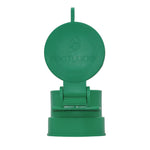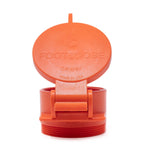You have no items in your shopping cart.
Water seepage can pose a serious threat to any building’s foundation. It can cause slab leaks, encourage mold growth, and erode the surrounding earth, damaging the entire structure.
Foundation drains – also called footing drains – are tools that construction contractors use to mitigate this risk. These are exterior drainage systems located just outside the foundation wall. They drain out excess water and prevent it from seeping into the building’s foundation.
What Is a Foundation Drain?
Foundation drains are typically made out of rigid drain tile or corrugated pipe. The drain surrounds the structure’s foundation entirely and contains thousands of tiny perforations that let water in. Once in the pipe, the water flows safely away from the structure, protecting the integrity of the foundation.
Since the system provides drainage around the house foundation, they are sometimes called perimeter drains. The slope of the drain carries water away from the structure and towards the sewer system.
Typically, contractors wrap the drain in permeable mesh and cover the surrounding area with layers of gravel before backfilling it with soil. This prevents dirt and debris from clogging the pipe and preventing drainage.
Two broad types of foundation drain systems are footing drains and French drains:
- French drains are made of a perforated pipe laid beside the foundation wall. The slope of the pipe extends away from the structure. The pipe is surrounded by a porous material, like gravel, then backfilled with soil.
- Footing drains surround the entire perimeter of the foundation wall at the same level as its footing. The pipe collects water that would otherwise leak through the top of the footing into the structure’s basement. Footing drains are covered with gravel right up to the surface.
What to Consider When Building a Footing Drain
Local rainfall and soil conditions are the primary factors to consider when building a footing drain. The right footing drain pipe material appropriate pipe size for a residential foundation drain changes from place to place. Make sure to check for slab leaks while you are looking for leaks.
Some of the things you will want to pay attention to when installing drain tile around your house include:
- Building Code Requirements. The International Residential Code (IRC) section 1 requires drains surrounding concrete and masonry foundations to remain below grade. It provides an exception for drains in very well-drained soils, as well as soils with sand and gravel mixtures.
- Drainage Boards for Heavy Rains. Heavy rains and flooding can overload a foundation drain system. Drainage boards can mitigate this risk by quickly draining off water and preventing hydrostatic pressure next to the foundation wall.
- Drain Materials. Most contractors prefer to use rigid drain tile for basement footer drains. Perforated pipe is also popular. Flexible corrugated plastic pipe is an expensive option, but it may get crushed during the backfilling process.
- Soil Moisture. Moist soils do not drain as well as dry soils. Flood-prone areas where water collects on the surface (which may feel damp even when there is no rain) are often better-served with other drainage solutions.
- Proximity to Trees. The S. Department of Housing and Urban Development requires trees to be planted no closer to the foundation than their eventual height. Tree roots can fill perimeter drains, suck water from the soil, and damage the foundation drain system.
- Placement. The best spot to place a drain pipe is near the base of the building’s footing. Tile doesn’t necessarily have to slope, but contractors should avoid low spots that can easily fill with silt.
Foundation Drain Advantages and Drawbacks
Many contractors rely on footing and French drains to protect foundations from settlement. They justify foundation drain installation with the following arguments:
- Foundation drains prevent water from accumulating near the building’s foundation, greatly reducing the risk of settlement. They keep stagnant water from collecting, discouraging the breeding of pests like mosquitoes.
- Soil erosion is less of a risk when subsurface water is effectively drained away from the structure. Since the direction of seepage points towards the drain, the density of subsurface soil grows as more water flows towards (and through) the drainage system.
- Effective water drainage helps remove toxic organisms from stagnant water. Moist soil and stagnant surface water can become a breeding ground for disease-ridden pests. Consistent accumulation can drown out plant life, creating swamp-like surface conditions that no homeowner wants.
While footing drains successfully reduce the risk of settlement and soil erosion, they present several disadvantages to contractors and homeowners:
- Foundation drain installation requires digging into the soil around the entire structure. This means that any landscaping elements on the surface will have to be replaced after installation. The same problem will occur every time the system requires any kind of maintenance as well – since contractors will have to expose the foundation to get to the drain.
- Footing drains made of perforated pipe are susceptible to clogging. Even with a fine mesh in place, silt can accumulate inside the pipe, making drainage increasingly difficult over time. Eventually, homeowners will have to dig up the pipe and unclog it at great expense.
- Subsurface drainage systems can carry nitrate through the drain pipe and deposit it in local water sources. Nitrate is one of the most common drinking water contaminants found in rural areas, where it causes methemoglobinemia, also called “blue baby disease.”
Learn More About Foundation Drain Installation and Maintenance
Construction professionals, industrial water engineers, and homeowners should be aware of the dangers of soil erosion and settlement in waterlogged soil conditions. Foundation drains are just one of several drainage options that protect structures from foundation damage, basement leaks, and more. Find out which drainage solution is best-suited to your property.









